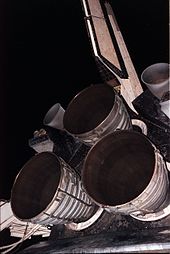Aerojet Rocketdyne RS-25
The Aerojet Rocketdyne RS-25 is a rocket engine that uses liquid oxygen as an oxidizer and liquid hydrogen as fuel . It acted as the main engine of the Space Shuttles ( English Space Shuttle Main Engine , SSME). In the future it is to be used as the main engine of the super heavy lift rocket “ Space Launch System ” (SLS).
properties
The RS-25 is based on a patent from MBB Ottobrunn (USP 3,595,025) and was developed together with Rocketdyne. It was then built by Pratt & Whitney Rocketdyne .
The engine has a mass of 3.2 tons. The nozzle has a length of 2.87 meters and a maximum diameter of 2.39 meters. It is one of the most powerful engines in the history of space travel . Each engine produces over 2000 kN of thrust. The temperature in the combustion chamber is 3300 ° C. The fuel is pumped to the combustion chamber at around 450 bar and the oxidizer at around 300 bar by means of turbo pumps . The high pressure pumps work at speeds of 35,360 / min and 28,120 / min.
The RS-25 is reusable and should be able to be reused up to 55 times with a maximum thrust of 109%. However, this number was never reached.
Due to the reusability and high efficiency as well as the complexity, the engine is very expensive to manufacture and maintain. Unofficially gave NASA -Staff the SSME-production price of around 50 million US dollars to each.
development
The first run of an SSME took place in October 1975. As is usual with the development of new rocket engines, numerous problems arose during testing. During a test, an engine exploded and destroyed the test stand.
Use on the space shuttle
Each space shuttle was equipped with three RS-25 main engines mounted on the stern of the space shuttle. The fuel components were in the large outer tank . The engine burn time at takeoff was about eight and a half minutes. During the further mission, the SSME were no longer needed. The US space shuttle used the Reaction Control System and the Orbital Maneuvering System to maneuver in orbit . The main engines for the space shuttle program were tested with the Main Propulsion Test Article (MPTA-098) .
They were gimbaled and swiveled hydraulically by 10.5 °. This compensated for the torque that occurred due to the change in the center of gravity and the thrust vector after the booster burned out and dropped.
In contrast to the solid fuel rockets , the thrust of the liquid propulsion units could be regulated or they could be switched off in flight in the event of a malfunction. In several missions, the main engines were switched off again shortly before the solid fuel rocket ignited, thus aborting the start. During the ascent phase of the Challenger during the STS-51-F mission , the center main engine switched off automatically after five minutes of flight time due to a malfunction. Despite the lower thrust, a so-called abort to orbit was carried out and most of the mission objectives were achieved, albeit in a lower orbit than originally planned.
Use with the SLS
The RS-25 is to serve as the main drive of the new American SLS carrier system in the future . The 16 units of the last development stage (RS-25D) remaining after the end of the space shuttle program are to be used on the first flights of the SLS, after which a simplified version of the engine (RS-25E) is to be used in the SLS. For this purpose, NASA ordered a further six new engines from Aerojet Rocketdyne in November 2015. The contract includes the resumption of the production facilities that have been mothballed for ten years as well as the production of the engines until 2022 or 2023 with a total volume of 1.16 billion US dollars.
Web links
- mainengine.de: Space Shuttle Main Engine (SSME)
- Pratt & Whitney: SSME ( Memento of August 13, 2009 in the Internet Archive ) (English)
- NASA: Space Shuttle Main Engines (English)
- Patent: US 3595025 / DE1751691A1
Individual evidence
- ↑ NASA Engineering Innovations - Propulsion , accessed on November 18, 2013 (PDF; 15 MB) (English)
- ↑ Space News: NASA Eyes Alternative to Shuttle Main Engine for Heavylift , March 20, 2006 (English)
- ↑ Aerojet Rocketdyne wins propulsion contracts worth nearly $ 1.4 billion. Spaceflight Now, November 27, 2015, accessed January 19, 2016 .


